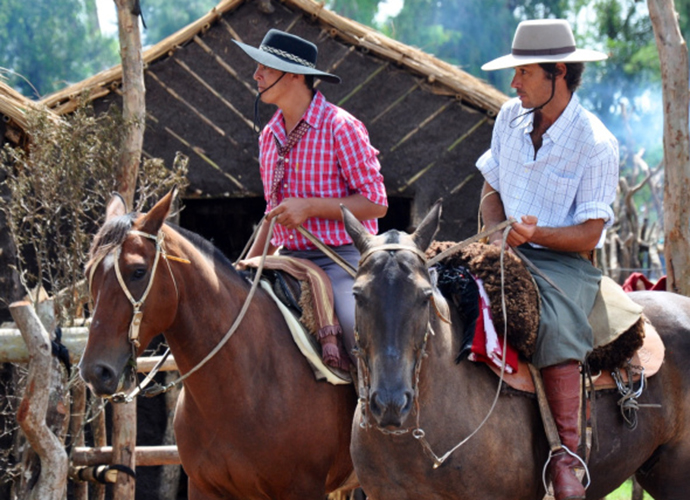Uruguayan gauchos have their origins in the reducciones (missions) set up by the Jesuits to protect and ‘civilise’ the native Guaraní people; here they planted maté, herded cattle and learnt leatherworking. After the closure of the missions their mestizo descendants adopted a semi-nomadic lifestyle, and as the cattle industry developed from simply rounding up wild cattle to more organised ranching, they became the most sought-after workers, thanks to their skills on horseback and their ability to survive happily in the campo with almost nothing but a large knife and an unrelieved meat diet.
Darwin observed Uruguayan gauchos in 1832 and wrote in detail about their use of the lazo (lasso), made of plaited leather strips, to catch cattle, and the bolas, two or three stone balls wrapped in leather and linked by a leather rope, to catch rheas. When he tried to use the bolas himself, he got one ball caught on a bush and another around his horse’s leg, causing general hilarity but fortunately no injuries to man or beast. He strongly approved of the gauchos’ character, finding excuses for their faults:
The gauchos, or countrymen, are very superior to those who reside in the towns. The gaucho is invariably most obliging, polite, and hospitable: I did not meet with even one instance of rudeness or inhospitability. He is modest, both respecting himself and country, but at the same time a spirited, bold fellow. On the other hand, many robberies are committed, and there is much bloodshed: the habit of constantly wearing the knife is the chief cause of the latter. It is lamentable to hear how many lives are lost in trifling quarrels. In fighting, each party tries to mark the face of his adversary by slashing his nose or eyes; as is often attested by deep and horrid-looking scars. Robberies are a natural consequence of universal gambling, much drinking, and extreme indolence.
Even now, gauchada refers to an act of kindness or a good deed.

In Montevideo it’s well worth visiting the Museo del Gaucho with its displays of silverware and leatherware. Holy Week sees the Semana Criolla in the Prado Park, with rodeos and asados (barbecues) But to see gaucho culture at its best you should head for Tacuarembó during the second week of March, for the Fiesta de la Patria Gaucha (Gaucho Homeland Festival), with perhaps 3,000 horsemen (and maybe a few women) competing in rodeo events, and many more people in gaucho garb applauding, shopping for crafts and more practical rural bits and pieces. In the evenings there’s asado con cuero (a cow barbecued with the skin still attached) and performances of dance, song and poetry. If you happen to be here in winter, you’ll find horse races held on Sundays in many villages.
More information
Want to learn more about the gauchos? Check out Tim Burford’s guide:
